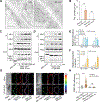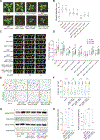ABLs and TMKs are co-receptors for extracellular auxin
- PMID: 37979582
- PMCID: PMC10827329
- DOI: 10.1016/j.cell.2023.10.017
ABLs and TMKs are co-receptors for extracellular auxin
Abstract
Extracellular perception of auxin, an essential phytohormone in plants, has been debated for decades. Auxin-binding protein 1 (ABP1) physically interacts with quintessential transmembrane kinases (TMKs) and was proposed to act as an extracellular auxin receptor, but its role was disputed because abp1 knockout mutants lack obvious morphological phenotypes. Here, we identified two new auxin-binding proteins, ABL1 and ABL2, that are localized to the apoplast and directly interact with the extracellular domain of TMKs in an auxin-dependent manner. Furthermore, functionally redundant ABL1 and ABL2 genetically interact with TMKs and exhibit functions that overlap with those of ABP1 as well as being independent of ABP1. Importantly, the extracellular domain of TMK1 itself binds auxin and synergizes with either ABP1 or ABL1 in auxin binding. Thus, our findings discovered auxin receptors ABL1 and ABL2 having functions overlapping with but distinct from ABP1 and acting together with TMKs as co-receptors for extracellular auxin.
Keywords: ABL1; ABL2; ABP1; ABP1-like proteins; TMKs; auxin; transmembrane kinases.
Copyright © 2023 The Authors. Published by Elsevier Inc. All rights reserved.
Conflict of interest statement
Declaration of interests The authors declare no competing interests.
Figures







Comment in
-
Found: The missing discriminators of cell-surface auxin receptors.Cell. 2023 Dec 7;186(25):5438-5439. doi: 10.1016/j.cell.2023.10.021. Cell. 2023. PMID: 38065077
References
MeSH terms
Substances
Grants and funding
LinkOut - more resources
Full Text Sources
Other Literature Sources
Molecular Biology Databases
Research Materials
Miscellaneous

